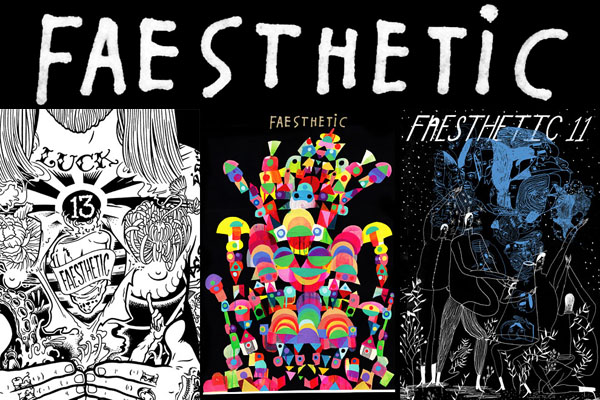Faesthetic is changing the way zines are marketed and redefining that for which they stand. Much more than a high-quality art showcase, Faesthetic has grown into a taste-maker for the 21st Century art scene.
This glossy, invitation-only art zine began as a magazine showcase for established talent and up-and-coming artists, but it has since expanded into the areas of gallery shows, T-shirt design, and poster art, and it has even lent its name and style to a New York Fashion Week event. Exclusive, high-brow, and part of a growing media empire characterized by artistic partnerships — is this the future of zine culture?

Created in 2001 by Dustin A. Hostetler, Faesthetic has only produced 12 issues so far, but its involvement in cultural events and its highly active blog lend it influence beyond a few dozen pages of actual printed product. Hostetler intends to continue producing one issue per year and to add an Internet-based supplement in the near future. However, the focus of Faesthetic remains squarely on its glossy, high-quality print issues.
Originally, Hostetler’s idea was to create a tangible product in response to the boom in PDF zines during the past few years. The fact that Faesthetic is a polished, collectible art book is obviously important to his aesthetic. “I wanted something I could tuck away in a box, put it in my attic, and that my grandchildren could find some day,” he explains.
The exclusivity of the zine might seem strange in today’s open-source sharing culture, but Hostetler is adamant about its benefits. He says, “I am trying to make something that artists want to be in.” Though Faesthetic has an open submission process, Hostetler picks and chooses the artists he wants to be in the zine (his title on the Faesthetic website reads “publisher & curator”). He also aims for a range of interesting work by both established and newcomer artists — the “new and undiscovered talent,” as he says.

Being featured alongside a bigger artist is valuable to a newer one, and Faesthetic readers get a first glimpse at this new talent. It’s no wonder that artists still express such interest in the publication. “I haven’t had any issue with my roster,” Hostetler says, “and instead think it really pushes everyone to submit the best work they can.” The results speak for themselves; Faesthetic has been consistently well received by the art and print communities, and it has gained the attention of everyone from Threadless and Clamor magazine to Shepard Fairey. The latest issue, #13, features art by Mark Mothersbaugh, among others.
The other side of the zine is, of course, the multimedia events that Faesthetic participates in on an increasingly regular basis. Hostetler says that his connection with an event or brand usually starts with their interest in Faesthetic‘s artists, and then Hostetler figures out what shape Faesthetic’s contribution will take. “If there is a theme to the project, I’ll approach a selected group of artists and give them the rundown,” he says. “I’ve been lucky enough to work with projects that treat my artists with respect.” These events increase brand recognition for Faesthetic as well as put artists in touch with more people and open up more opportunities.

Instead of publishing online or on a smaller scale, Faesthetic‘s print process is expensive and time consuming. In a world that wants to write off print media, why does Hostetler do it? For one thing, he isn’t convinced that the state of publishing is so dire: “While everyone is screaming that print has been dead for the past decade, I’m seeing quite the opposite.” He notes that there’s been a resurgence of print zines in the past few years, and that self-publishing has breathed new life into the medium. Faesthetic has found its own solution: marketing to enthusiasts and professionals in the art field that are willing to pay a bit extra for some polish and quality.

